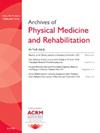Center of Pressure- and Machine Learning-based Gait Score and Clinical Risk Factors for Predicting Functional Outcome in Acute Ischemic Stroke
IF 3.6
2区 医学
Q1 REHABILITATION
Archives of physical medicine and rehabilitation
Pub Date : 2024-12-01
DOI:10.1016/j.apmr.2024.08.006
引用次数: 0
Abstract
Objectives
To investigate whether machine learning (ML)-based center of pressure (COP) analysis for gait assessment, when used in conjunction with clinical information, offers additive benefits in predicting functional outcomes in patients with acute ischemic stroke.
Design
A prospective, single-center cohort study.
Setting
A tertiary hospital setting.
Participants
A total of 185 patients with acute ischemic stroke, capable of walking 10 m with or without a gait aid by day 7 postadmission. From these patients, 10,804 pairs of consecutive footfalls were included for analysis.
Interventions
Not applicable.
Main Outcome Measures
The dependent variable was a 3-month poor functional outcome, defined as modified Rankin scale score ≥2. For independent variables, 65 clinical variables including demographics, anthropometrics, comorbidities, laboratory data, questionnaires, and drug history were included. Gait function was evaluated using a pressure-sensitive mat. Time-series COP data were parameterized into spatial and temporal variables and analyzed with logistic regression and 2 ML models (light gradient-boosting machine and multilayer perceptron [MLP]). We derived GAIT-AI output scores from the best-performing model analyzed COP data and constructed multivariable logistic regression models using clinical variables and the GAIT scores.
Results
Among the included patients, 70 (37.8%) experienced unfavorable outcomes. The MLP model demonstrated the highest predictive performance with an area under the receiver operating characteristic curve (AUROC) of 0.799. Multivariable logistic regression identified age, initial National Institutes of Health Stroke Scale, and initial Fall Efficacy Scale-International as associated factors with unfavorable outcomes. The combined multivariable logistic regression incorporating COP-derived output scores improved the AUROC to 0.812.
Conclusions
Gait function, assessed through COP analysis, serves as a significant predictor of functional outcome in patients with acute ischemic stroke. ML-based COP analysis, when combined with clinical data, enhances the prediction of poor functional outcomes.
基于压力和机器学习的步态评分与临床风险因素预测急性缺血性卒中功能预后的中心。
目的研究设计: 一项前瞻性单中心队列研究:研究设计:前瞻性单中心队列研究:研究设计:前瞻性单中心队列研究:共有 185 名急性缺血性脑卒中患者,他们在入院后第 7 天能使用或不使用步态辅助工具行走 10 米。对这些患者的 10804 对连续脚步进行了分析:主要结果测量:因变量为三个月的不良功能结果,定义为修改后的兰金量表评分≥2。自变量包括65个临床变量,包括人口统计学、人体测量学、合并症、实验室数据、问卷调查和用药史。步态功能使用压敏垫进行评估。时间序列 COP 数据被参数化为空间和时间变量,并通过逻辑回归和两个 ML 模型(LightGBM 和多层感知器 [MLP])进行分析。我们从分析 COP 数据的最佳模型中得出了输出 GAIT 分数,并利用临床变量和 GAIT 分数构建了多变量逻辑回归模型:在纳入的患者中,有 70 人(37.8%)出现了不良预后。MLP 模型的预测性能最高,接收者操作特征曲线下面积(AUROC)为 0.799。多变量逻辑回归确定年龄、初始美国国立卫生研究院卒中量表和初始国际跌倒功效量表为不利结局的相关因素。结合 COP 导出的输出评分的多变量逻辑回归将 AUROC 提高到了 0.812:通过 COP 分析评估的步态功能可显著预测急性缺血性卒中患者的功能预后。基于机器学习的 COP 分析与临床数据相结合,可增强对不良功能预后的预测。
本文章由计算机程序翻译,如有差异,请以英文原文为准。
求助全文
约1分钟内获得全文
求助全文
来源期刊
CiteScore
6.20
自引率
4.70%
发文量
495
审稿时长
38 days
期刊介绍:
The Archives of Physical Medicine and Rehabilitation publishes original, peer-reviewed research and clinical reports on important trends and developments in physical medicine and rehabilitation and related fields. This international journal brings researchers and clinicians authoritative information on the therapeutic utilization of physical, behavioral and pharmaceutical agents in providing comprehensive care for individuals with chronic illness and disabilities.
Archives began publication in 1920, publishes monthly, and is the official journal of the American Congress of Rehabilitation Medicine. Its papers are cited more often than any other rehabilitation journal.

 求助内容:
求助内容: 应助结果提醒方式:
应助结果提醒方式:


